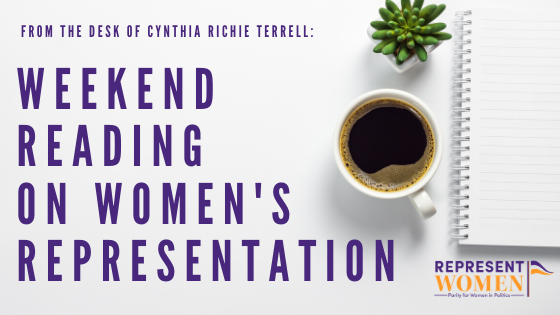
Weekend Reading on Women’s Representation is a compilation of stories about women’s representation in politics, on boards, in sports and entertainment, in judicial offices and in the private sector in the U.S. and around the world—with a little gardening and goodwill mixed in for refreshment!
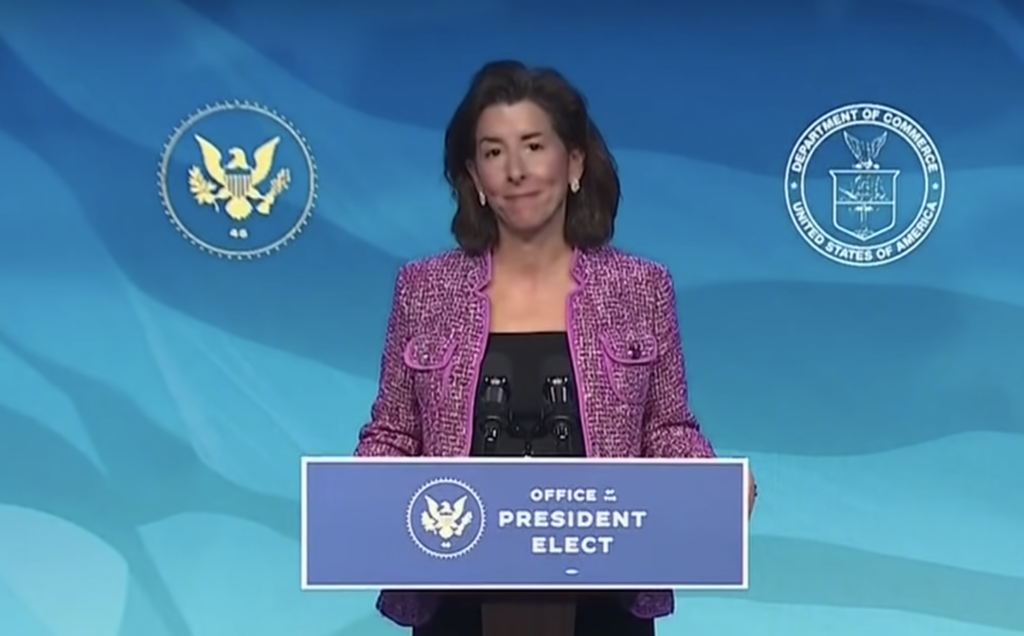
Next week, Kamala Harris will become the first woman in our nation’s history to take the oath of office to serve as vice president of these United States. The leadership team that she and President-Elect Joe Biden have assembled is the most diverse in history.
If confirmed by the U.S. Senate, the new Cabinet will be majority people of color and gender-balanced, according to this story on CNN.com:
President-elect Joe Biden on Friday introduced key nominees for his economic and jobs team, including Rhode Island Gov. Gina Raimondo for commerce secretary and Boston Mayor Marty Walsh for labor secretary.
The two picks mark the completion of Biden’s announcements for his Cabinet secretary nominees, and come less than two weeks from the President-elect’s inauguration.Biden touted the diversity and historic firsts in his Cabinet, and said he had fulfilled his promise of having his Cabinet look like America.
“This will be the first Cabinet ever that is evenly composed with as many women as men in the Cabinet. This will be the first Cabinet ever with the majority of people of color occupying this Cabinet,” the President-elect said. He noted his nominees would, if confirmed, include the first female treasury secretary, the first African American defense secretary and the first Native American Cabinet secretary.
Biden on Friday also announced Isabel Guzman, the director of California’s Office of the Small Business Advocate, to lead the Small Business Administration and Don Graves, who was the executive director of the President’s Council on Jobs and Competitiveness at the Obama White House, as his nominee for deputy secretary of commerce.
Biden spoke of the challenges his administration will face when he takes office in the middle of a pandemic and economic downturn, when so many Americans have lost their jobs and are struggling financially.

Since the riot at the Capitol last week there have been quite a few articles written about the dysfunction in our politics that is caused by our antiquated voting system. The Fair Representation Act that I have written about before would not only elect multiple constituencies of color and more women to the House; it would also dramatically reduce polarization and provide lawmakers an incentive to work together on our behalf.
One article on the need to focus on democracy reform that has had a lot of traction is this one in Crooked by Waleed Shahid and Nelini Stamp—here is an excerpt:
The United States has an 18th-century, antebellum system of elections. Most countries that have democratized since then adopted one form or another of proportional representation, which gives political parties power in proportion to their public support. Parties that win 15 percent of the votes in the election get 15 percent of seats in the legislature. In our single-member, winner-take-all system, the candidates who win the most votes walk away with all the political power. If you win 49 percent of the votes, you generally win zero percent of the power. As the New York Times editorial board put it, “single-member districts have become a threat to the health of America’s representative democracy.”
For much of the country’s history, this system functioned because the parties were loose coalitions with distinct regional profiles, and both parties could compete in most of the country. Before the Civil War, that system depended on compromise with slave owners. The party system collapsed in the 1850s when slavery dominated the national agenda. For much of the 20th century, our winner-take-all system worked only by keeping Jim Crow off the agenda.
Over the past few decades, the U.S. has undergone what political scientists call “the great sort,” culminating in a Democratic Party that enjoys dominant support among voters of color and those who live in cities and inner-ring suburbs, and a Republican Party that’s dominant among white Christians and in rural and exurban regions. As political identity has become bound up in racial and geographical identity, each parties’ supporters increasingly believe the other party’s supporters pose a threat to their way of life…..
Yet despite representing a clear minority, Republicans can contend for power at the national level because of the structural advantages that the Senate, the electoral college, and single-member House districts confer. They don’t have to compete for the votes of anyone outside their narrow base in order to win vast power; they control enough veto points to block the Democratic agenda even when they lose; and at an individual level they’re more likely to be defeated by right-wing primary challengers than by Democrats in a general election. McConnell’s top aide even suggested days after the insurrection that Republicans would continue along the path of Trumpism, with or without Trump: “If you can replicate his draw amongst rural, working-class voters without the insanity, you have a permanent governing majority.”
Single-member, winner-take-all congressional districts have created the incentive structure for Republicans to make increasingly destructive appeals against multiracial democracy in order to gain power. Without a political reconstruction and deep reforms to that antebellum electoral system, there is no stopping Trumpism as the dominant force in the Republican Party. The Republican Party must be broken up. The institutions of our democracy—the House of Representatives, the Senate, the Electoral College, and the Supreme Court—have created an incentive for the Republican Party to drive the republic off the cliff. Even if some Republicans oppose Trump’s ethno-nationalism and show interest in starting a new party, they have few incentives for doing either under our current rules.
Many Democrats believe that their sole task is to defeat Republicans, and that change will follow naturally. But the structural incentives that led Republicans to embrace Trump in the first place remain in place, even as they lost the Senate and the presidency, and likely even as they’ve been tarred with complicity in an armed insurrection.
The only way to change their behavior is through the adoption of a robust democracy reform agenda—one that will help America complete its transformation into a pluralistic, multiracial democracy and splinter the Republican Party as it currently exists into oblivion. The campaign finance reform, voting rights, and redistricting provisions of H.R. 1 represent big steps forward as do efforts to eliminate the filibuster, reform the courts, abolish the Electoral College, grant statehood to Washington, DC, and allow Puerto Ricans a referendum on statehood or independence. These efforts would help stem the Republican Party’s ability to entrench minority rule in our democracy. But alone, these reforms themselves can’t stop a Republican Party steeped in white-grievance politics from returning to unchecked power.
This Congress should thus enact further democracy-expanding reforms that would require Republicans to attempt to appeal beyond the shrinking white rural minority our existing institutions are designed to empower.
The Fair Representation Act, H.R. 4000, would restructure the rules of our democracy to achieve this. Under the current system, over 70 percent of congressional general elections are uncompetitive and Republicans can routinely win more seats than Democrats while still losing the popular vote. H.R. 4000 would reform the system to create large districts spanning urban and rural areas that would elect multiple members of Congress through ranked-choice voting. Such districts would make urban and rural votes count equally, and would reward all parties for competing everywhere.
A new system like this would create a multi-party, proportional-representation system in the House similar to the kind many other democracies around the world enjoy. For those honest conservatives who genuinely oppose Trump and Trumpism (or for dishonest conservatives who would nevertheless like to shake off the stench of complicity with insurrectionists), proportional representation would allow them to create their own party without fearing that they’d be permanently shut out of power. Many of us on the political left, who often find ourselves at odds with the leadership of the Democratic Party, also find this idea appealing.
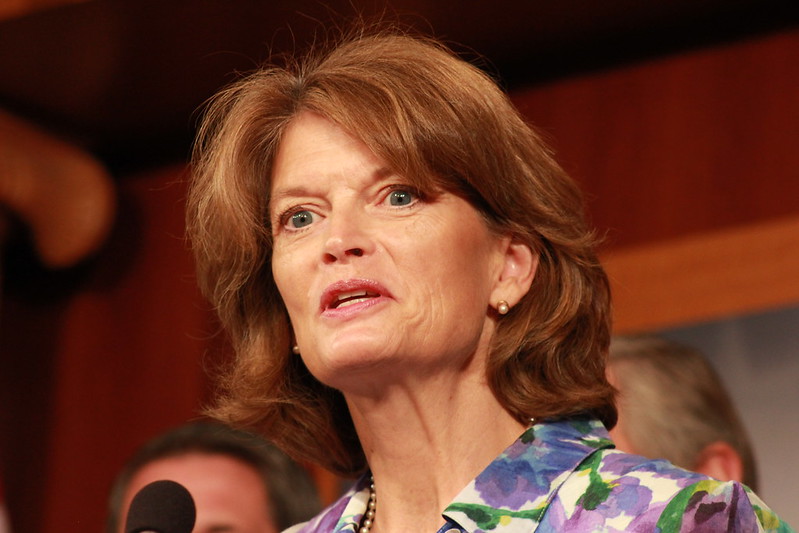
A prime example of the impact of a shift to a saner electoral system is reflected in this article in The Washington Post by Lee Drutman about the impact of the newly-adopted ranked choice voting system on Lisa Murkowski’s political future:
On Friday, Sen. Lisa Murkowksi (R-Alaska) became the first Republican senator to call on President Trump to resign. “I want him out,” Murkowksi told a reporter. “He has caused enough damage.”
In the same interview, Murkowksi also raised doubts about whether she would remain in the Republican Party. “I will tell you, if the Republican Party has become nothing more than the party of Trump, I sincerely question whether this is the party for me,” she said.
Similar thoughts may be going through the heads of quite a few elected Republicans right now. But unlike every other elected Republican up for reelection in 2022, Sen. Murkowski comes from a state that uses ranked-choice voting. That means she is in a rare position. She can leave the Republican Party without taking a big risk that she won’t be reelected. That’s because under ranked-choice voting, third-party or independent candidates can compete without being dismissed as spoilers.
What is ranked-choice voting?
First, a quick primer on ranked-choice voting: Ranked-choice voting lets voters mark their first-choice candidate first, their second-choice candidate second, their third-choice candidate third, and so on. Each voter has only one vote but can indicate their backup choices.
If one candidate has an outright majority (more than 50 percent) of first-place rankings, that candidate wins, just like a traditional election. But if no candidate has a majority in the first round, the candidate in last place is eliminated. Voters who had ranked that candidate first have their votes transferred to their backup — that is, the candidate they ranked second.
In a single-winner election (now used in Maine, Alaska, San Francisco and the Australian House, among other places), the ranking transfer process continues until a single candidate gathers a majority.
In other words, Murkowski has the option of running as an independent in 2022 or forming her own party. She can then attract votes from Democrats and Republicans, while allowing her Democratic and Republican supporters to still have a backup vote for a Democrat or Republican, ensuring the vote won’t be wasted if Murkowski finishes third in the initial round.
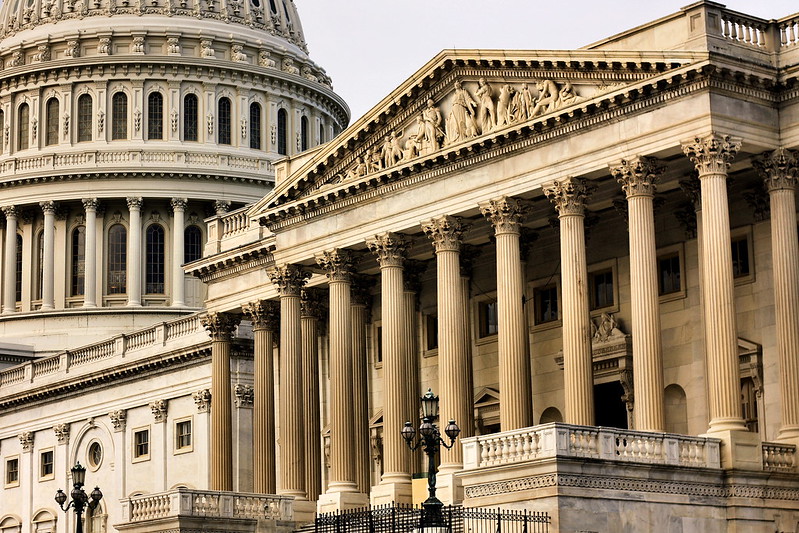
Anna Fahey and Kristin Eberhard of The Sightline Institute wrote this piece about the failure of our democratic institutions that were on full display last week and the solutions to be found in electoral reform:
America’s antiquated voting methods surely contributed to shockingly sanguine responses from Republican party leaders as well. Anyone gerrymandered safely in a red district had no motivation to speak out against illegal actions that a portion of their base backed. Any office holder living in fear of being outflanked in their next primary by a farther-right candidate had reason to keep mum as well. And state election laws that disproportionately disenfranchise Black and Latino voters buffer lawmakers from true accountability to all their constituents. These flawed systems—gerrymandering, party primaries, voter suppression—played a part in handing elected officials a pass to shrug it off rather than take a stand for US democracy.
But as we reel from the events of the week, it’s worth remembering that the November 2020 elections, held in the face of compounding challenges posed by lies, lockdowns, postal disruptions, and pandemic fears, can be chalked up as a success for voter participation. Voters turned out in record numbers, rallied by massive, long-term organizing and mobilization strategies, and, in many key places, fired up by calls for racial justice that swept the country in 2020. Across the country, elections officials carried out safe, secure, well-orchestrated early, absentee, and in-person voting, and conducted swift, accurate counts.
It’s worth remembering now too that though the information chasm driving some of our partisan differences is hard to bridge, there are some election reforms immediately at hand to shore up democracy going forward, solutions that we can implement with bipartisan support.
Red Alaska just approved ranked choice voting, freeing its candidates from the fear of being “primaried” and opening them up to principled positions they believe the average Alaskan will appreciate. The effect is immediately visible, as Alaska Senator Lisa Murkowski speaks out against the insurgents and declares she will not be held hostage by a party that doesn’t respect the Constitution and the rule of law. In Georgia, a Republican Secretary of State implemented Automatic Voter Registration in 2016, which added more than a million new voters to the rolls by 2020. And another Republican Secretary of State mailed absentee ballot applications to all registered voters to ensure they had the option to safely vote from home during the pandemic. The number of absentee voters soared from 6 percent to 26 percent, indicating that election officials’ efforts helped a million voters participate who might not have done so if they had to show up in person during a pandemic.
These are successes to build on and hopeful reminders that from the beginning US democracy has been an aspirational experiment, deeply flawed but a work in progress, and that its evolution toward a more perfect ideal counts on our unrelenting work to improve it. Many times Americans have come together as a country to enact reforms that expanded voting rights, often driven by crisis and by the hard work of the most marginalized.
We have the tools to build US democracy back better, and to mend the cracks that have been pried open by subversion. Ranked Choice Voting and Automatic Voter Registration are two of the road-tested, common-sense solutions described in our new book, Becoming a Democracy. And we propose a four priority election reforms for Congress to tackle in their first 100 days, here. The division, doubt, and license to destruction on display on January 6 showed us that it is more urgent than ever to spread these democracy solutions to every state and change the dynamics that allowed elected officials to look the other way as sedition played out in the halls of the Capitol.

Conversations about electoral reforms are happening, of course, around the world—as evidenced by this article by Sam Vassallo about women’s representation in Malta. Vassallo reports on a new rule being proposed to reach gender parity by adding women members of parliament if gender balance isn’t achieved through the first vote:
A bill to lure more Maltese women into politics through gender quotas will be tabled and discussed today as Parliament resumes after Winter recess.
Spearheaded by Parliamentary Secretary for Equality and Reforms Rosianne Cutajar, the bill includes Constitutional amendments to ensure more of the underrepresented sex make it to the House of Representatives ahead of the next general election. Gender-neutral people are also included in the definition of the underrepresented sex.
It was tabled just before the pandemic forced Parliament to stop, and will now face its second reading.
At the centre of the bill is a gender correcting mechanism, which would see a maximum of 12 seats added to Parliament for women if they make up less than 40% of the House after an election.
Currently, just 13% of MPs are female.
In the current parliamentary scenario, the Labour and Nationalist parties would get six seats each, which would be taken by women who failed to get elected on the first round of the electoral process.
If a third party were to be elected, they would also benefit from the corrective mechanism.
Both parties have endorsed the bill, but questions arise as to whether it could lead to the tokenism of women. A study done by Lovin Malta found that women with less than 20 first count votes could make their way to the House should the bill pass.
However, the authors of the bill argue that political representation is not about merits and competence.
“It is about representing the people,” the document proposing the gender quotas reads. “Political representation is about rights and justice. How can the fact that men occupy more than 80 per cent of the parliamentary seats in the world be justified?”
It’s clear that the government is keen on bringing more women into power, with a recent Cabinet reshuffle proving to be the most representative of females in Malta’s history.
But even then accurate representation remains an issue. Just three of Malta’s twenty ministers are women, while four make up the 26-person Cabinet.
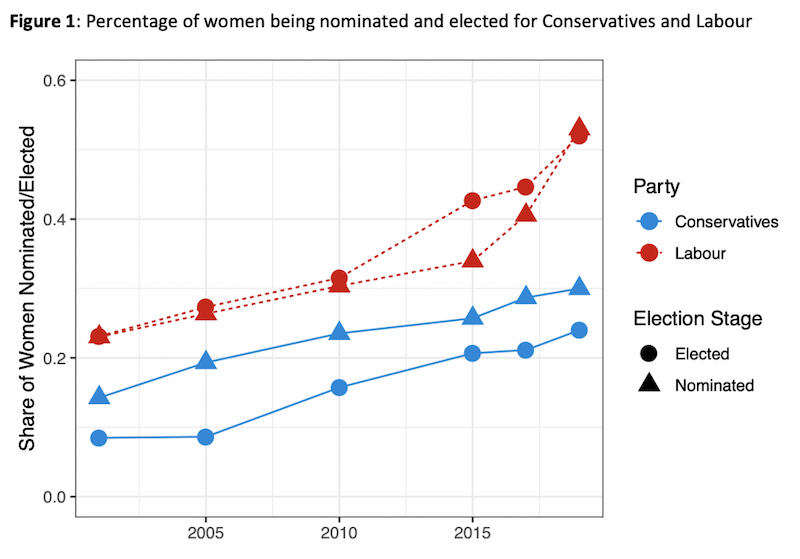
The Labour Party in the U.K. has adopted rules and strategies to increase the number of women members of parliament as this article by Jens Wackerle in the London School of Economics blog explains:
For a while now, there has been discussion of the ‘glass cliff’ of women’s representation. The term is related to the more common term ‘glass ceiling’, which describes the fact that women reach a certain level in organizations, but then fail to progress higher (for example women might become local council members, but not MPs, or regional head of production, but not CEO). The glass ceiling, meanwhile, describes the situation that women are often promoted and put in leadership positions when times are bad, for example when a company is failing, cases in court are likely to be lost, and parties are fairly sure they will lose an election. The latter leads to women being nominated in places where they have very little chance of winning. In other words, a party might increase the number of women candidates, but mostly in constituencies they are all but certain to lose.
We can see such a glass cliff for the Conservatives, as Figure 2 shows: in constituencies that the Conservatives were less than 25% likely to win, more than 40% of candidates were women. Meanwhile, in constituencies that the Conservatives were more than 75% sure to win, only 25% of candidates were women. Efforts of the Conservatives to increase the share of women among candidates, such as the A-List or Theresa May’s ‘Women2Win’ campaign did help to increase the number of women among candidates somewhat, but many of them were nominated in very bleak situations.
Meanwhile, Labour nominated women fairly evenly across constituencies: places that they were likely to win had about as many women running as those they were likely to lose. Since the early 1990s, Labour has been using All-Women Shortlists to nominate women in particularly promising situations. While hotly discussed among party supporters, the media and the public (and briefly banned due to a court challenge in 2001), they had one very clear effect: many more women were nominated, and they were nominated in places they could win. Consequently, this targeted, top-down measure was highly effective in addressing women’s underrepresentation in politics: The share of Labour MPs that are women rose from 25% to 50% in less than 20 years.
One way in which women’s representation spreads across parties, countries, and regions is the phenomenon of contagion. Once one party nominates a woman in a certain constituency, other parties and/or neighbouring constituencies might be more likely to do so as well. Reasons for this may be positive newspaper coverage, pressure from women’s associations within a party, or the fear of losing women voters. On the national level, parties often observe other parties increasing women’s representation and feel compelled to do so as well. Especially, parties on the left prioritise women’s representation once competitors from the left challenge them on the issue. In the UK, the Liberal Democrats too use a version of All-Women Shortlists. While discussions on the use of the latter have been going on in the Conservative party, the leadership has refrained from taking such strong measures.
Geographically, I find that one constituency nominating a woman will lead to other constituencies being more likely to do so as well in the subsequent election, if they are reasonably close. This means that a party can increase women’s representation in a certain region by having only some of the constituencies nominating women, which then also increases the likelihood of others doing the same.
Across the political spectrum in many countries, party leadership is working to increase the number of women among MPs. However, parties in single-member district systems often have a hard time doing so: if a party nominates only a single candidate per constituency, quotas are difficult to construct and local parties have historically often nominated men to run in such contests. The example of the Labour Party shows how a combination of reserving certain electorally promising seats for women and subsequently neighbouring constituencies being likelier to nominate women, led to the party doubling the share of women among their MPs in 20 years.Meanwhile, the example of the Conservatives shows that soft measures such as recruitment efforts and public relations campaigns will only get you so far – there might be some additional women candidates, but they are also likely to run in constituencies they have little chance of winning. These measures are simply not enough to increase the share of women among MPs by a considerable margin.
Also of interest this week is this piece by Clara Ferreira Marques on Bloomberg Opinion about ways to address women’s inequality in Russia:
Since the start of the year, Moscow’s subway has employed female drivers, one of several hundred job categories opened up to the fairer sex. It’s a welcome return for opportunities formally rescinded two decades ago — even if it came with a special-edition Barbie. Unfortunately, the moves only scratch the surface of changes Russia’s women really need to see in 2021.
Research shows that while they have historically participated relatively equally in the workforce, Russian women still earn almost a third less than men — one of the widest gaps among high and middle-income nations. As elsewhere, they’ve been more harshly affected by the pandemic given their over-representation in hard-hit sectors like retail and the fact many hold more precarious jobs. They’ve suffered disproportionately, as a result, from frugal state support. Finally, they face the pressures that come with a traditionalist state concentrated on reversing a pattern of demographic decline.
Job limitations do matter. Enshrined in law in 2000, they kept women from 456 occupations deemed too dangerous, arduous or unhealthy, including working as a lumberjack, fighting fires or driving tractors. A 2019 decision to open 356 of those came into effect this year. It’s good news, especially for women in Russia’s traditional company towns, and a symbolic win with economic consequences — together, those 456 roles represent 4% of all occupations.There are still 100 mostly industrial roles that remain formally out of bounds, perpetuating stereotypes and limiting opportunities.
The problem runs much deeper. Russia celebrates International Women’s Day with flowers and a public holiday, and has high-profile female figures like Elvira Nabiullina, governor of the central bank. Yet two in three Russians say they wouldn’t want a female president, according to a survey last year by pollster VTsIOM. Sadly, that figure has risen since 2016.

This piece about Regina King’s commitment to gender parity was a reminder of the much-needed work for women’s representation in the entertainment sector:
When actress Regina King won a Golden Globe back in 2019 for Best Supporting Actress in “If Beale Street Could Talk,” she made an impassioned declaration and a promise to audiences.
For every project she would produce, King vowed to employ 50% women, and she challenged Hollywood and beyond to join her in reaching for this goal.
Two years later, King is one step closer to her declaration as an executive producer and director of the new feature film “One Night in Miami.” While she didn’t accomplish gender parity on this film, she says making it was “a magical experience.”
“As far as achieving gender parity, that was a difficult task. It was a task that we were not able to accomplish, even though we were trying to accomplish it,” she says. “But what we were able to accomplish is, and I can’t say diversity parity, but we were able to put together a crew that was predominantly of color and that did not identify as cis white male.”
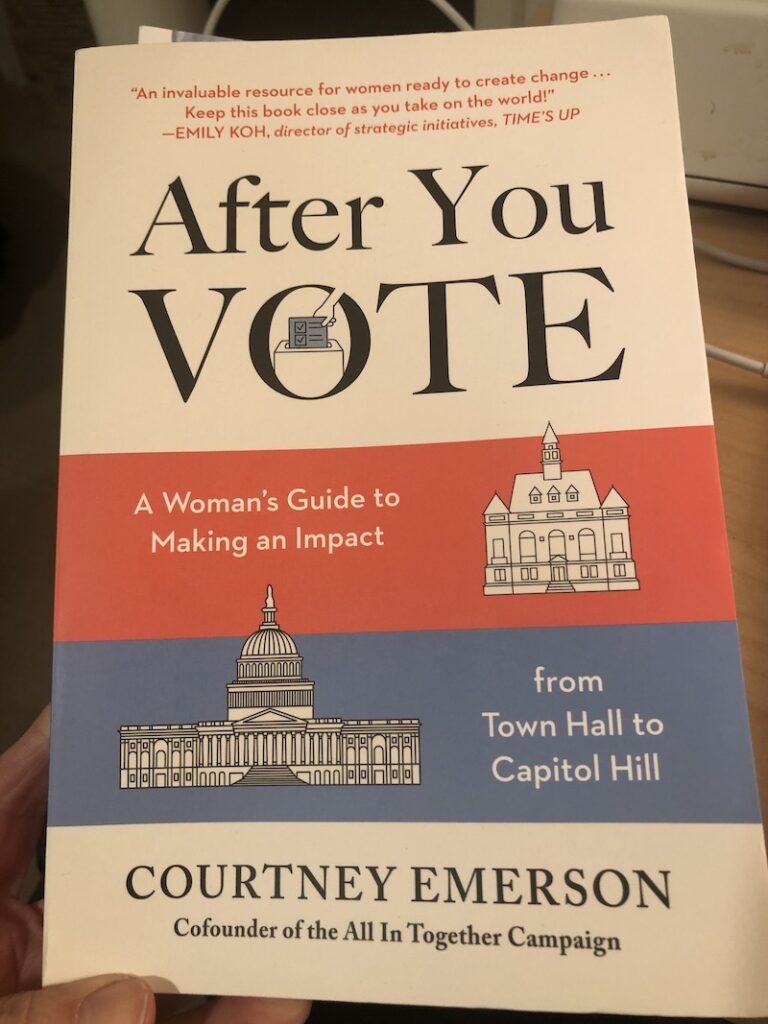
I was excited to get a copy of All In Together co-founder Courtney Emerson‘s new book After You Vote that is a terrific guide for women in politics. Courtney offers a compelling case for reforms that include ranked choice voting and expanding the number of members of the U.S. House of Representatives to increase the number of women in office:
Today, women in the United States are more educated and politically ambitious than ever before. However, the record numbers of women running for office, casting votes, and marching for change haven’t translated into full and equal political participation. Despite significant progress, women are less likely than men to engage in a range of important political activities—from speaking up on the issues they care about to holding their representatives accountable.
Equal parts information and inspiration, “After You Vote” is both a primer and call-to-action for women of all ages who want to exercise their voices and engage more fully in civic life. It’s the ultimate guide to political engagement, filled with practical (and proven) tactics to help women make their voices heard and have an influence on the issues they care about most.
This book will help you:
*Brush up on civics—federal, state, and local
*Prioritize your issues
*Use the most effective advocacy tactics
*Stick with it for the long haul (politics is a marathon, not a sprint!)
The question isn’t if you can create change on behalf of the issues you care about. You can. The question is: What’s at stake if you don’t?
Don’t forget to listen to the RepresentWomen playlist on Spotify and check out the suggested reading from the team at RepresentWomen:

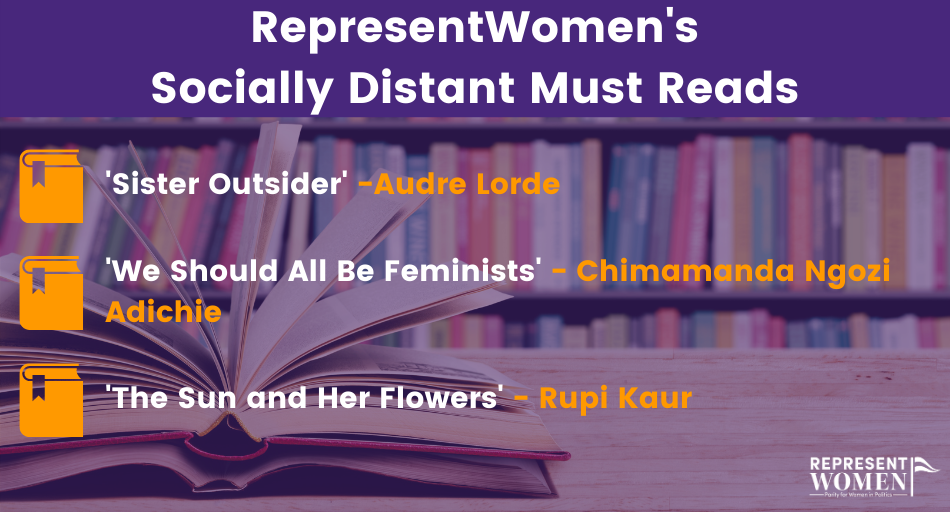
Our opponents are using the lame duck period—the time between now and when the new president is inaugurated, and a new Congress convenes—to do as much damage as they can. Help ensure Ms. remains strong and independent during this period of challenge and change. If you found this article helpful, please consider supporting our independent reporting and truth-telling for as little as $5 per month.





